绪论
软硬件协同,制作深度学习硬件
理论课,讲座,Lab
专用电路
目标:做一个类似于Google TPU中的某计算模块
benchmark: ML
每4周一个Lab,无期中期末
作业:
AlexNet Paper
Quantization of CNN
DNN
Training & Inference
Training: forward and backward
Inference: backward
Model

五类算子:

特征提取器:卷积层,池化层;
分类器:全连接层
线性卷积层
边界扩充(Padding):在图像周围扩展一圈0,避免多次卷积导致数据尺寸越来越小
卷积步长(Stride):卷积核每次跳的步数。可以用来让数据尺寸快速变化
非线性函数-激活函数
非线性-正则化函数
非线性-池化函数
池化层
池化层减小图片的尺寸,从而减小参数的数量和计算量。
最大池化:在池化窗口内取最大值作为输出。
- 复杂度低,硬件实现容易
- 最为常用
平均池化:取池化窗口内的平均值作为输出。
$L^2$ 池化法:对所有的数计算平方后累加求和再开平方。
- 计算复杂度高
- 几何平均池化的复杂度更高
线性全连接层
将特征图映射为分类结果
Softmax 层
有的模型在输出层使用softmax对输出进行归一化:
- 输入和输出规模相同
- 归一化计算,让较大的值凸显,让较小的值被抑制,从而决定分类概率
卷积神经网络的总体结构
Dataset
数据集的建立:数据采集,数据标签,数据清洗,数据增强,数据分割
Cost function
Optimization
- 梯度下降法
- SGD
- 动量法:计算过去的平均梯度
- AdaGrad法:累加梯度方差
- RMSProp:按时间降低学习率
- Adam 算法:指数加权移动平均值计算梯度动量和二次矩
- SGD简单,但是训练过程边长,自适应算法会更高效
Evaluation
回归问题指标
PSNR
分类问题指标
- Top1 accuracy
- Top5 accuracy
IoU
Intersection of Union?
检测任务评价指标 mAP
mean average precision
真阳性TP: 预测为真,实际为真
假阳性FP:预测为真,实际为假
假阴性FN:预测为假,实际为真
查全率(召回率,Recall)和查准率(准确率,Precision)
置信度衡量的是模型认为有效的自信程度。我们先将结果按照置信度从高到低排序。
mAP是不同查全率下,最高查准率的平均值。
网络结构的发展和讨论
分类任务
AlexNet
- 使用多个卷积层,有效提取图像特征
- ReLU 提高训练速度
- Dropout、数据增强扩大训练集,防止过拟合
VGG
- 使用 3 * 3 的卷积核取代 AlexNet 的大卷积核
- 提升收敛速度
- 参数量更少
- 可以构建更深的网络,有更多的非线性变换,还有更强的表征能力
- 参数预初始化策略
ResNet
?
目标检测
Two-stage v.s. One-stage
Two-stage
先画框,再分类
MS CoCo Dataset
- 用的最多的还是目标检测任务
R-CNN
- 输入图像
- 提取候选框
- 每一个候选框提取单独的特征
- 进行分类
Fast R-CNN
- 输入图像
- 一次特征提取
- 提取候选框
- 进行分类
Faster R-CNN
- 输入图像
- 一次特征提取
- 提取候选框
- 进行分类
One-stage
YOLO
五代发展,最广泛的目标检测算法
对于每一个像素,都会输出一个对应的特征向量,包含:
- 二分类:是物体中心的置信度
- 回归:偏离物体中心的长度 $\Delta x$ 和 $\Delta y$
- 分类:对应的物体分类以及置信度
- 回归:该像素所代表的物体的长宽,YOLO有一些基础框(anchor),输出值是相对基础框的形变 $\Delta h$ 和 $\Delta w$
NMS (Non-Maximum Suppression)
Bounding boxes for one instance may overlap.
Method: For each type, use NMS to eliminate redundant bounding boxes (greedy approach).
Workflow:
- Sort candidate bounding boxes by classification confidence.
- Adding the boxes b with most confidence to output list, and delete it from the candidate boxes.
- Calculate IoU between b and other boxes bi. If > threshold, delete bi.
- Repeat until no candidate bounding boxes.
序列模型(Serial Model)
to process Speech, text, video, audio, etc.
Feature:
- The data input is in the time sequence.
- There is a correlation between the data before and after.
So the model should have the ability to “store” information.
Speech dataset: TIMIT
- It consists of recordings of 630 speakers of 8 dialects of American English each reading 10 phonetically-rich sentences.
- It also comes with the word and phone-level transcriptions of the speech.
Video dataset: DAVIS
The Densely Annotation Video Segmentation dataset (DAVIS) is a high quality and high resolution densely annotated video segmentation dataset under two resolutions, 480p and 1080p.
There are 50 video sequences with 3455 densely annotated frames in pixel level. 30 videos with 2079 frames are for training and 20 videos with 1376 frames are for validation.
NLP dataset: GLUE
General Language Understanding Evaluation (GLUE) benchmark: Standard split of data totrain, validation, test, where labels for the test set is only held in the server.
- Sentence pair tasks
- MNLI, Multi-Genre Natural Language Inference
- QQP, Ouora Ouestion Pairs
- QNLI, Ouestion Natural Language Inference
- STS-B The Semantic Textual Similarity Benchmark
- MRPC Microsoft Research Paraphrase Corpus
- RTE Recognizing Textual Entailment
- WNLI Winograd NLI is a small natural language inference
- datasetSingle sentence classification
- SST-2 The Stanford Sentiment Treebank
- CoLA The Corpus of Linguistic Acceptability
Models
RNN: Recurrent Neural Network
- one to one
- one to many
- many to one
- many to many
- many to many

损失函数的计算:
单个时刻:
整个序列:
然后可求梯度:

循环神经网络存在梯度爆炸或梯度消失,因此无法处理长期的依赖关系。
LSTM: Solving the Gradient
Transformer
Self attention:
Quantization
Fixed-point and floating-point representation
Fixed Point arithmetic
Fixed point with slope and bias
apply a linear transform on fixed point:
Floating-poing arithmatic

IEEE 754 Floating Point Standard
- Called Biased Notation, where bias is number subtracted to get real number.
- IEEE 754 uses bias of 127 for single precision, 1023 for double precision.

fp15(helf precision)

Hardware implications

加法下定点数比浮点数功耗小得多,但是乘法下定点数和浮点数的性能差不多。
Low bit Fixed-point representations on digital system
Quantization for deep learning
- Post-training quantization
- Quantization-aware training
Post-training quantization
Choose the optimal threshold
No saturation is bad
Classic research for quantization methods
Basic structure
Weight Quantization & Activation Quantization

Dorefa Net
- quantization for gradient
- normalize data to ensure the data distribution not change after quantization
- uniform noise to offset the quantization noise for gradient
- replace accumulate with bitcount operation
- result is that gradient precision is most sensitive in TAQ(G > A > W)
INQ
- quantization first half and freeze the other, then unfreeze other to train normally
- exchange the first half and second half, and repeat above

Pact
- clipping the activation before quantization is better
Different layers need different α
alpha should be learnable
Outlier quantization
- Use different quantized bits to quantize different weights. Some weight can have higher precision while others not.

Quantization interval learning
- Most of the weights are very small. Minor weights can have too large value.
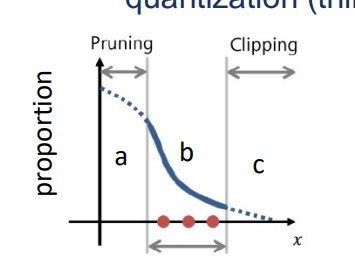
a should be pruned, c should be clipped, only b worths quantizing.
Binary neural networks (BNN)
- Networks with weights composed of {-1, 1}
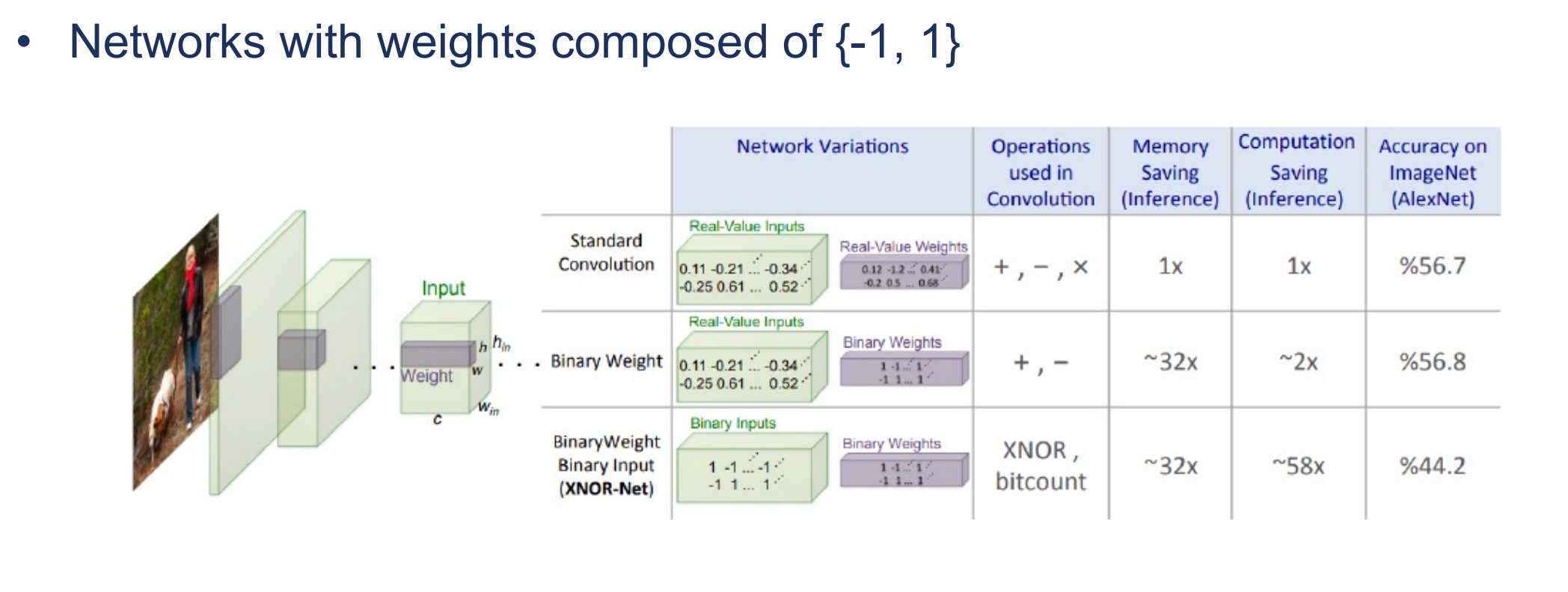
- 计算时长跟精度有平方反比的关系,优化是平方的
- 存储跟精度只有线性的关系,优化是线性的,由于BNN bit数少,总的参数量更多,实际上存储没怎么优化
- BNN 大幅优化了计算,但是存储没变,此时存储成为了瓶颈
State-of-the-art hardware support for low
precision DNNs
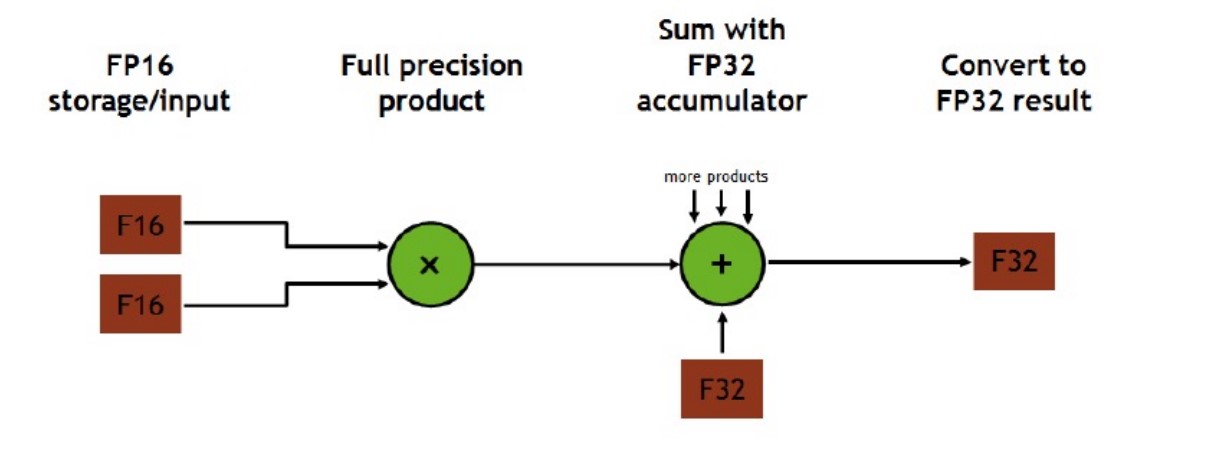
Pruning
稀疏矩阵是指矩阵中大部分元素都是0的矩阵。获得稀疏矩阵,有助于加速训练和推理速度。
Sparsity: New Dimension For Efficiency
稀疏性的来源:
- 剪枝 - 权重
- ReLU - 激活
- Domain Specific
Weight Sparsity: Pruning
剪枝方法:
- 很多参数其实是很接近0的数
- 因此,低于某一阈值时,直接将其赋0.但是这样会影响精度。
- 还可以用添加正则项的方法(Weight decay):
- $CF = MSE_{train} + \lambda \sum_i w_i^2$
- $CF = MSE_{train} + \lambda \sum_i |w_i|$
Activation Sparsity: ReLU
Weight Sparsity Perspective
不同的稀疏程度:

Unstructured Sparsity
Han Song@NIPS2015 的剪枝策略:

第一轮训练后,将所有接近0的神经元剪除,再重新对剩下的进行训练(retrain)。
- 压缩比很高,而准确率几乎不下降
- 对于硬件并不友好,虽然有很多0,但是硬件上没法把它们压缩掉。
- 计算速度并没有提高,甚至降低了
Structural Sparsity
SSL 剪枝策略(Structured weight pruning)
- 不是剪一个神经元,而是把一行/一列/一个通道全部剪掉。(不过,不是真的剪枝,而是修改代价函数的正则项)
- 规则化的剪枝对硬件更加友好
代价函数的表达式:

- 成功在一般设备上加速了
Pattern Pruning
研究卷积核内非0的权重是如何分布的。

如果某个“分布模式”反复的出现,就可以对它进行压缩存储:
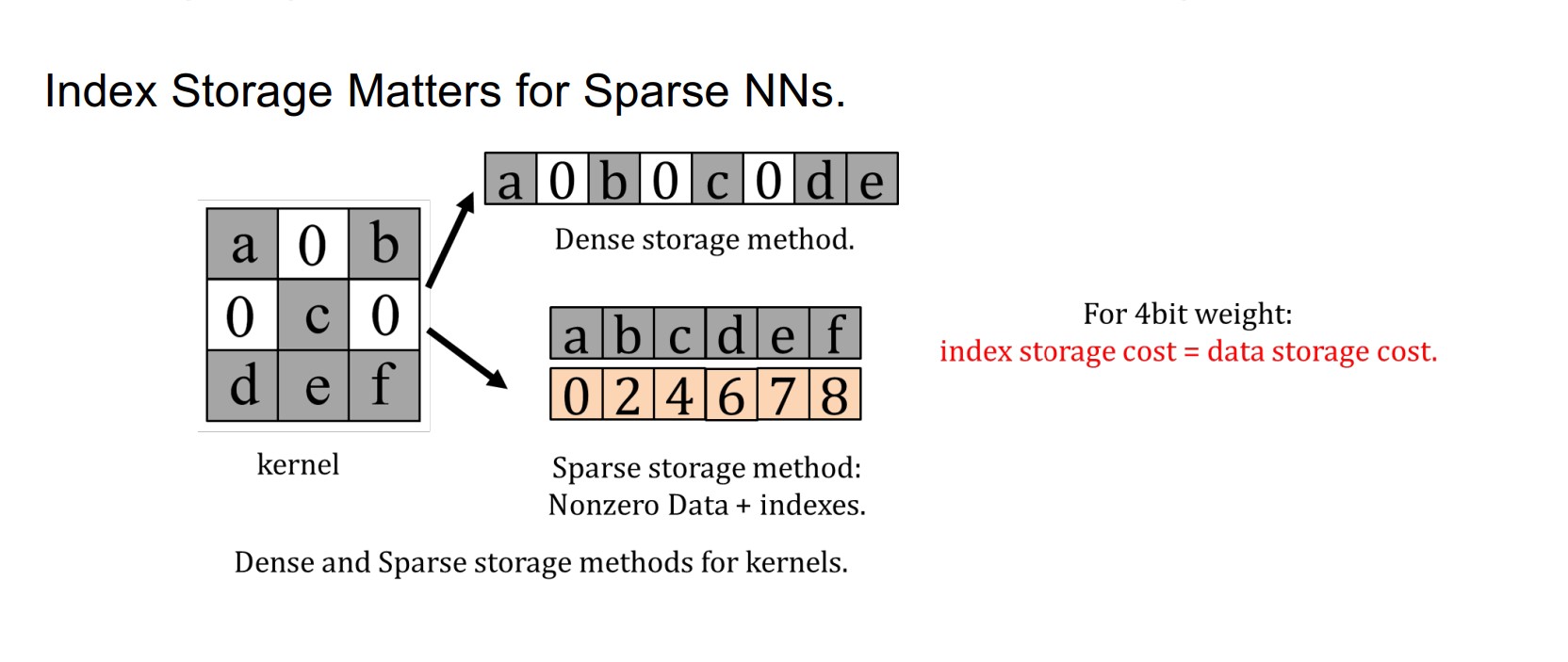
这一方面的成果:
- Flexible-Length Pattern Pruning:用概率统计方法得到特定的模式
- Fixed-Length Pattern Pruning:约束了模式里面非0元素的个数
Unstructured vs. structured
剪枝技术基本上已经成熟:
- Non-stuctured pruning
- 高压缩率
- 只能在特定设备上来降低功耗,但是性能其实没什么提升
- Structured pruning
- 对硬件更友好
- 低压缩率
(压缩率指的是训练的速度,即将数据“压缩”为神经网络的内蕴知识的能力。)
Frequency-Domain Sparsity
采用循环的卷积核
- 因为循环出现的元素,存储降低
- 计算等价为循环卷积,可以转换为 FFT 频域相乘,获得更高效的计算
Activation Sparsity Perspective
Inter-Frame Sparsity
一段序列的相邻帧之间具有相似性。因此只需要存储帧与帧之间的差值就行了。
Yuan Z@ISSCC 2020 的结论:
- 差分帧并不是稀疏的
- 差分帧的数值集中于低的bit位,分布集中
- 而高bit位很多都是0,非常稀疏
因此,可以对低 bit 位和高 bit 位拆分处理。
ROI Spasity:Input Dependent
ROI: Region of Interest
图像里包含的信息,有的丰富,有的贫乏,有的容易识别,有的很难识别。
- 稠密的输入用大核,稀疏的输入用小核?
基于不同的输入,采用不同的网络:
- 图像中难度高的区域通过更深的网络层
- 难度低的区域通过更浅的网络层
Leveraging Sparsity in Storage
如何压缩稀疏矩阵的存储空间?
Bitmask Compression
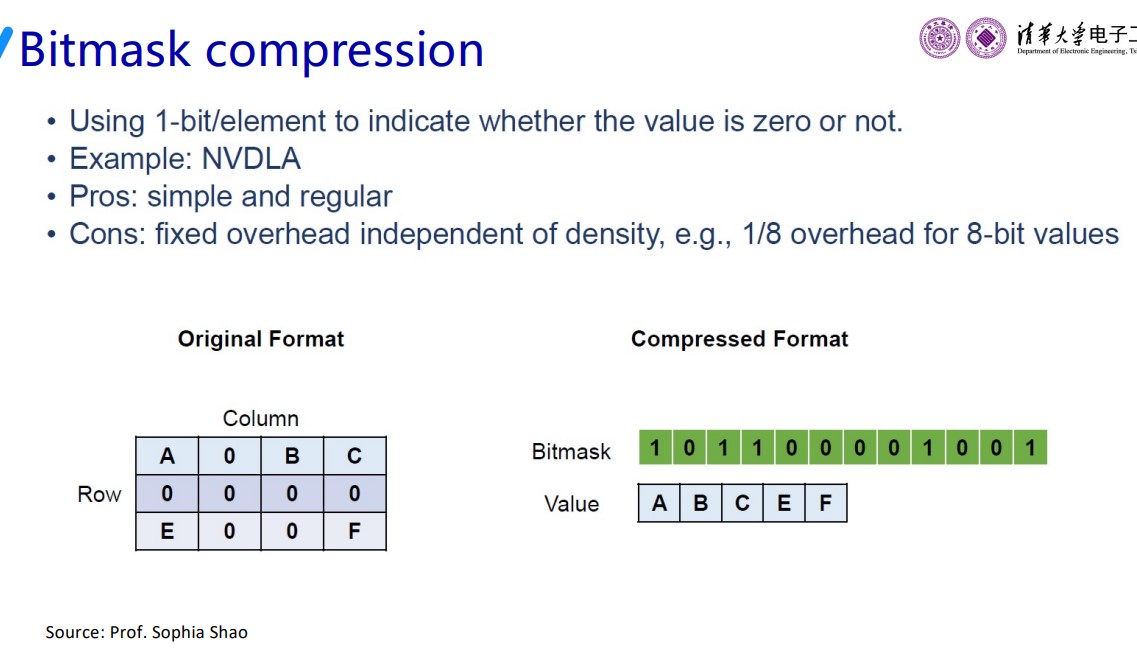
Run-Length Encoding
游程编码
(matlab警告)
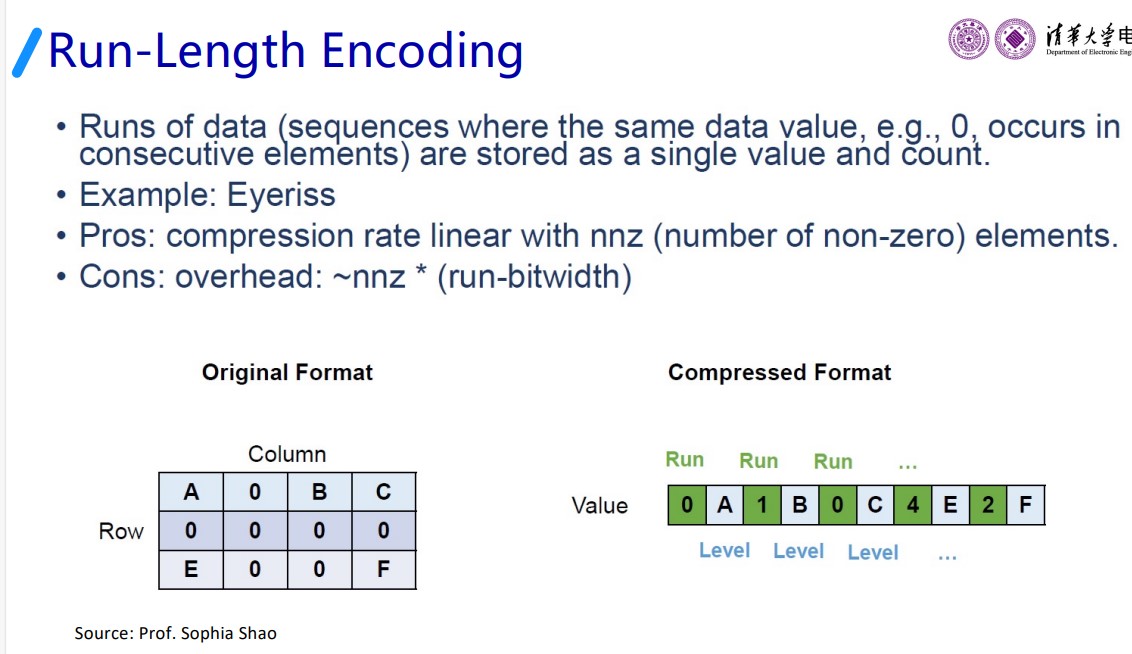
Compressed Sparse Row (CSR)
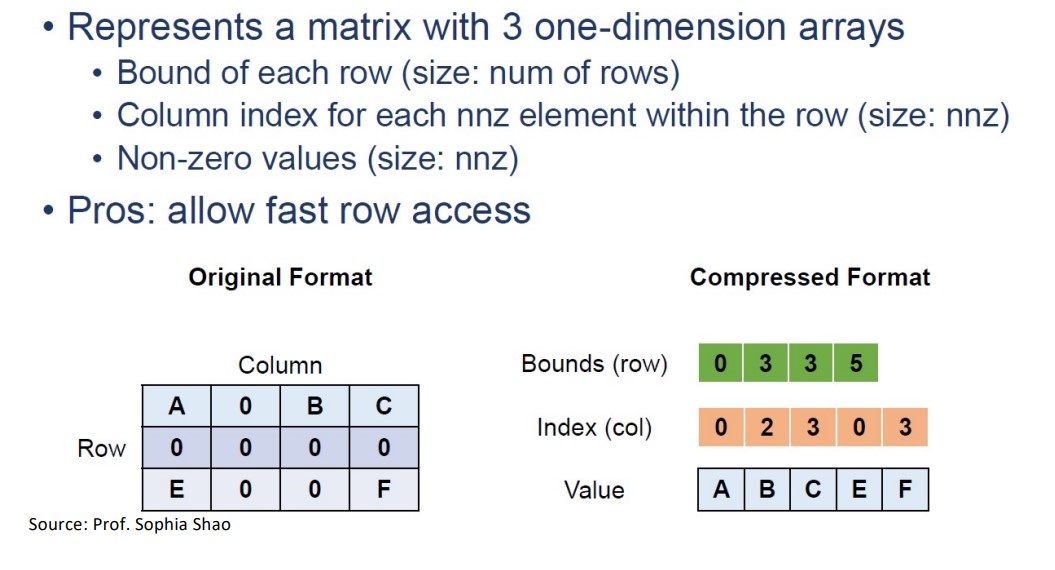
Compressed Sparse Column (CSC)
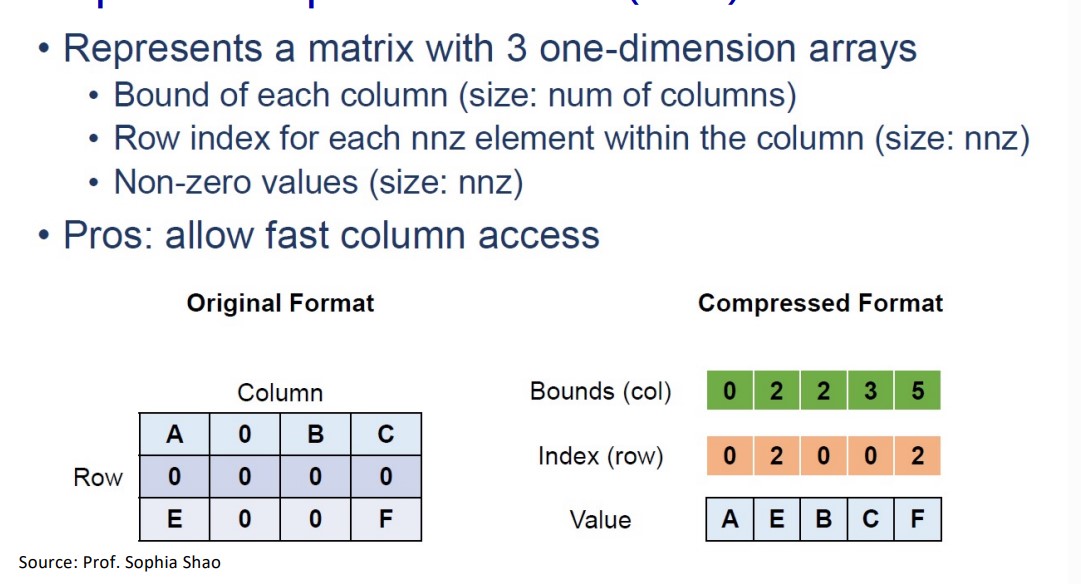
The Taco Notation
?
讲座
量化
Uniform & Non-uniform
Non-uniform quantization is not efficient for hardware deployment
Symmetric vs Asymmetric Quantization
Quantization Granularity: Layer-wise vs Channel-wise
Dynamic vs Static Quantization
静态的更常用,因为量化本身就是为了加快速度,动态量化却一边训模型一边更新量化区间的范围,反而减慢了速度。不过也有使用动态量化的时候(Mid Journey 生成图像)。
什么是mixed-precsion quantization?